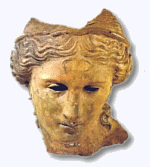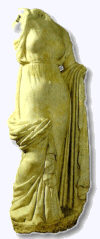 The
first god in Armenia was one of the language’s first sounds, ‘AR’, which
means sun or light. As the source of life, it became equated with
power and the supreme god. Ararat is mentioned as early as ca. 6000
BCE in the Sumerian epoch poem Gilgamesh, as the land of the mountains
where the gods live. The word Ararat can be divided into three words:
AR-AR-AT. AR-AR being a plural form or all encompassing god; ‘AT’
being an archaic version of the Armenian word ‘hat’, which means ‘a
piece of’. Thus Ararat meant ‘a piece of gods, or a piece of creation.
The
first god in Armenia was one of the language’s first sounds, ‘AR’, which
means sun or light. As the source of life, it became equated with
power and the supreme god. Ararat is mentioned as early as ca. 6000
BCE in the Sumerian epoch poem Gilgamesh, as the land of the mountains
where the gods live. The word Ararat can be divided into three words:
AR-AR-AT. AR-AR being a plural form or all encompassing god; ‘AT’
being an archaic version of the Armenian word ‘hat’, which means ‘a
piece of’. Thus Ararat meant ‘a piece of gods, or a piece of creation.
Early symbols for gods are closely connected with astral symbols. The first use of the sacred swastika and cross are found in ca. 20,000-15,000 BCE inscriptions in the Geghama Mountain Range. Carvings dating back to ca. 8500 BCE show symbols associated with astronomy, giving them a god like prominence: the sun, moon, and constellations were thought to be deities in themselves, and astral occurrences such as an eclipse or a comet were considered communication from the gods. By the 5th millennium BCE, Ancestral Armenians combined sun worship with sophisticated astronomy. They are now credited with assigning the constellations of the zodiac their design and names, and creating one of the first solar calendars based on 365 days in the year.
Also around the 5th millennium BCE a series of Vishaps (Dragon Stones) were erected on mountainsides throughout Armenia, near water sources. At first resembling fish (dragons in Armenian were thought to be huge fishlike creatures, something like a cross between a whale and a gigantic squid), the monolithic stones were later carved with snakes, the heads of beasts, swastikas and crosses.
Around 3000 BCE, Ancestral Armenians had created a specific iconography and pantheon of the gods. The Armenian gods were still centered on the worship of the sun, but by the Urartian period, they resembled Mesopotamian and Egyptian deities based on animal-human combinations.
Human deities emerged during the Armenian Hellenistic period. Though
bearing remarkable likeness to Greek gods and goddesses, which first gave
speculation as to their Greek origins, it is now thought that many of
the Greek gods are actually inherited from Ancestral Armenian sources,
with some coming from as far away as India. The heroic legends of
Hercules, for example, were first attributed to the legend of the Armenian
king-god Haik in the 3rd millennium BCE.
